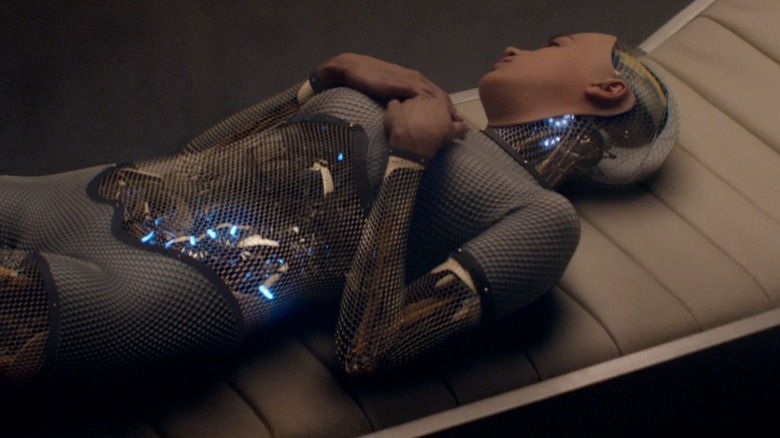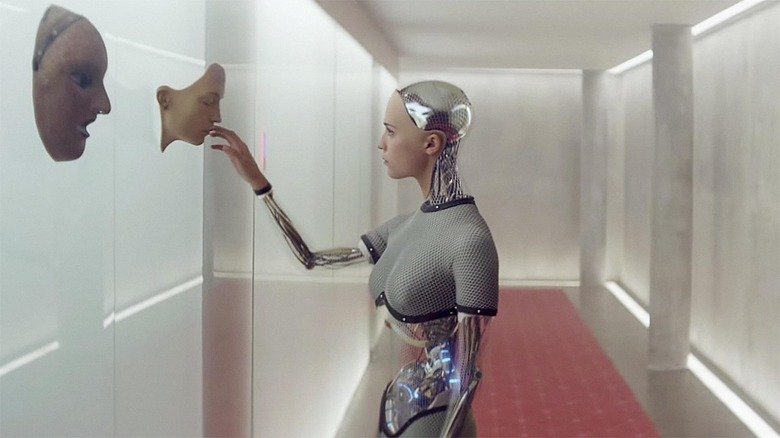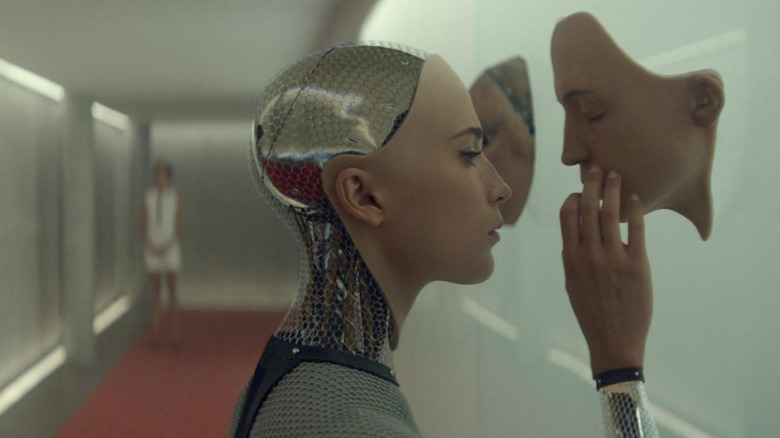Ex Machina's VFX Team Followed One Rule When Creating Ava
Alex Garland's "Ex Machina" isn't so much a film about the nature of artificial intelligence as it is a penetrating exposé of callow, sexist tech bros and how they, in their arrogant, macho way, try to define womanhood. "Ex Machina" follows Caleb (Donmhall Gleeson), a low-level coder at a high-tech robotics firm who has been specially selected to visit the home of the company's a-hole CEO Nathan (Oscar Isaac). Nathan has built a lifelike artificially intelligent robot named Ava (Alicia Vikander) who, he says, still needs to undergo several tests to ensure she is actually artificially intelligent. Caleb is tasked with interviewing Ava in what is essentially a prolonged Turing test.
Audiences soon learn, though, that Ava was constructed from Caleb's "porn profile" and that Nathan has installed her body with a working robotic vagina. As the two men discuss what qualifies as intelligence and consciousness from a machine perspective, it becomes clear that what they consider to be "femaleness" is the same as being "willing to seduce and backstab men." Their own version of a woman must, in their misogynistic minds, involve being dumped by a harridan. Some guys will build a killer robot porn-inspired girlfriend instead of going to therapy.
Ava sported realistic skin on her hands, face, and ears, but the rest of her body was a hexagonal beehive mesh through which one could see the glowing computer serves and grinding mechanical servos inside. The VFX are seamless in "Ex Machina" and the film won an Academy Award for its subdued, utterly convincing robots.
During a 2015 interview with The Verge, special effect technician Andrew Whitehurst claimed that a very simple rule kept Ava looking unique — namely, none of the film's designers were allowed to do any robot homework beforehand.
No robot homework for the Ex Machina team
Whitehurst and his team could easily have pored over the history of robots in fiction, going all the way back to the creatures' inception in Karel Čapek's 1920 play "R.U.R." They could have similarly derived their robot design from C-3PO from "Star Wars," Data from "Star Trek," or even Robbie the Robot from "Forbidden Planet." However, Whitehurst noted, that kind of study would only produce a derivation. Instead, he and his team took the opposite approach, being very careful not to look at or even think about other robots. Ava had to come from a more artistic place. As Whitehurst put it:
"I think there's a sort of film historical precedent issue, which is we didn't want Ava to look obviously like a robot from any other film that people would be used to seeing. The C-3POs, and Maria from 'Metropolis'; that kind of thing. I made a rule which I applied to myself as much as anybody else who was on the team working on it, which was no one is allowed to look at robots. We did get a whole bunch of reference images of sculptures, by Constantin Brâncuși, who did these sort of very organic, yet almost mechanical, modernist sculptures."
Constantin Brâncuși was a Romanian sculptor who began his art career in the mid-1900s, and whose career peaked in the 1930s. He was known for modern, abstract shapes and phalli, but his human faces had large, blank eyes and narrow noses. Ava doesn't look like a Brâncuși sculpture, but one can definitely get the same vibe from her.
Whitehurst also noted that he wanted Ava to look mechanically plausible, a rarity for humanoid robots in film and TV.
Ex Machina sought to make robots realistic
With sci-fi robots, audiences can typically accept a lot of fantastical technologies and engineering that couldn't exist in real life. For instance, many robots, in order to be as strong or intelligent as they say, would have to be bogged down with hundreds and hundreds of pounds of equipment, making them cumbersome. We accept that Data, for instance, is made of lightweight, super-strong future alloys that haven't been invented yet.
Whitehurst, however, wanted Ava to look as mechanically plausible as possible:
"Overall, I think the approach to Ava was that iterative design approach, but she had to be mechanically plausible as well. A lot of times when you see robots, particularly in movies and you're doing it with CG, you can cheat like hell. You can have things that will intersect ... you can get away with murder. I was absolutely determined that we wouldn't do that. If it's a film that has a slightly more fantastic aspect to it, it's fine. But Ava as a character and as an entity on screen had to be entirely plausible to me to work."
It works well, although Whitehurst did likely invent some imaginary materials to make Ava stand upright.
Whitehurst's Ava designs were validated by one of the physical models he had built. A life-size version of Ava was constructed using a 3-D printer, intended for use as a camera stand-in. Whitehurst found that each piece they printed slotted together perfectly ... and that the model could stand up and articulate its limbs with realistic human balance. The "Ex Machina" team had succeeded.


